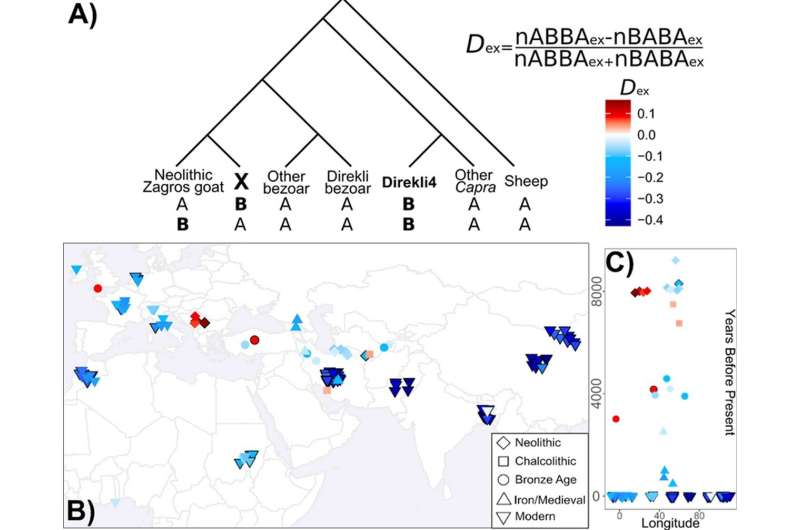Geneticists discover new wild goat subspecies via ancient DNA

Geneticists from Trinity College Dublin, together with a team of international collaborators, have discovered a previously unknown lineage of wild goats over ten millennia old. The research has just been published in the journal eLife.
The new goat type, discovered from genetic screening of bone remains and referred to as "the Taurasian tur", likely survived the Last Glacial Maximum (the ice age), which stranded their ancestors in the high peaks of the Taurus Mountains in Turkey where their remains were found.
A chance discovery at Direkli Cave
Over 12,000 years ago, hunter-gatherers in the Taurus Mountains of southern Turkey relied heavily on local game for food and subsistence. Located near the present-day village of Döngel and at an elevation of ~1,100 m above sea level, Direkli Cave was used for roughly three millennia (~14,000-11,000 years ago) as a seasonal camp for these hunters and may have been inhabited year-round.
"Among the artifacts found at Direkli Cave were large amounts of bone remains with distinct processing marks, indicating that wild goats were butchered there for consumption," says Dr. Kevin Daly, from Trinity's School of Genetics and Microbiology, who is first author of the research article.
"With the cave surrounded by high peaks, reaching ~2,200 m, the wild goat or bezoar ibex (Capra aegagrus) that inhabit the region today were likely the target of these Late Pleistocene hunters."
During genetic screening of goat bone remains from Direkli, the geneticists noticed something unusual: many of the goats carried mitochondrial genomes similar to a different species of wild goat.
Whereas the domestic goat is derived from the bezoar ibex, other species of wild goat are still alive today and are found in relatively restricted regions. These include the East and West Caucasus tur, two sister species (or subspecies) of wild goat now found only in the Caucasus Mountains in Georgia. Many of the Direkli Cave samples carried mitochondria related to these Caucasus tur, despite Direkli Cave being around 800 km from their current habitat.
Dr. Daly adds that "an even greater surprise came when we examined the Direkli Cave goats' nuclear genomes: while most looked like the bezoar ibex, as expected, one sample appeared different from the rest. This sample, Direkli4, showed more ancestral genetic variants than other Direkli goats, indicating it might have been a different species than the others."
To better understand this, the Trinity team collaborated with researchers from Muséum national d'Histoire naturelle of Paris to generate genetic data from other species in the Capra group.
A new lineage of Tur
The team was surprised to see that the Direkli4 sample in fact grouped with the Caucasian tur—appearing to be a sister group to both East and West types. Intrigued, the team screened more material from Direkli Cave and found an additional two samples with a "tur-like" genome, suggesting that a population of these tur relatives lived in the Taurus Mountains close to local bezoar ibex, with both hunted by humans in pre-historic times.
The team suggest a name for the discovered Taurasian tur: Capra taurensis or Capra caucasica taurensis; researchers still classify living tur as either subspecies or two distinct species.
As tur are larger and heavier than other wild goats, with a distinctive horn shape, it should be possible to identify a group of tur relatives in animal remains. Horn remains are absent at Direkli Cave, despite the large numbers of remains—possibly pointing to these being a valuable prize among hunters. But archaeozoologists in the team showed there were a lot of large-bodied goats at Direkli Cave—and possibly at other mountainous locations in southwest Asia.
"We hope that this will encourage re-evaluation and analysis of faunal remains in the region as there could be some exciting discoveries still to be found," added Dr. Daly.
A victim of climatic change and human activity?
The team suggest that the ancestors of tur lived across a broader geographical area over the past 100,000 years, from the Caucasus Mountains to the Taurus Mountains by the Mediterranean—and that climate change may have caused habitat fragmentation.
Dr. Daly says that "the Last Glacial Maximum, or ice age, may have made many areas inhospitable, forcing these goats to compete with other species. The Taurasian tur may have been a leftover group, restricted to the peaks in the Taurus Mountains. Increasing human activity would have placed additional pressure on the Taurasian tur, with hunting evidenced at Direkli Cave."
"While we don't know exactly when or how this goat lineage became extinct, additional genomic surveys in the region might show that their genomes live on in present day wild goats."
More information: Kevin G Daly et al, A novel lineage of the Capra genus discovered in the Taurus Mountains of Turkey using ancient genomics, eLife (2022). DOI: 10.7554/eLife.82984
Journal information: eLife
Provided by Trinity College Dublin



















